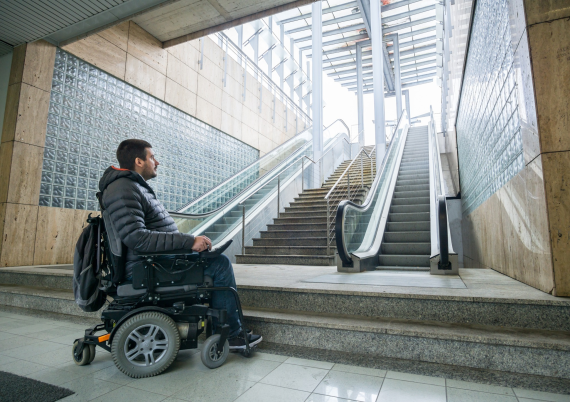
Landmark federal ruling ensures everyone can cross safely
Post filed in: Equity
Think of someone wanting to cross an intersection, advises Michael Foegelle, GSA’s National Accessibility Officer, where the raised concrete bumps seem designed to impede movement.
They are.
“The curb ramps and raised warning bumps are designed to help people with mobility and vision disabilities,” he says, to prevent them from entering an intersection before they are ready.
A decades-long push to provide a federal standard addressing accessibility concerns for safe movement along sidewalks, crosswalks, parking and transit stops hit landmark status August 8 when the U.S. Access Board issued a final rule on public right-of-way.
The Board, an independent federal agency that is currently vice-chaired by GSA Deputy Administrator Katy Kale, is the leading source of information and accessible design for people with disabilities. The Board was formed under the Rehabilitation Act of 1973 and is celebrating its 50th Anniversary. The new Public Right-of-Way Accessibility Guidelines (PROWAG) took effect September 7. They’re issued under the Americans with Disabilities Act of 1990 and the Architectural Barriers Act of 1968.
To help explain what the final PROWAG means for GSA, Foegelle said the curb ramps and warning bumps are often already in place because of local and state regulations. The latest effort incorporates those local and state policies into full-fledged federal policy.
“PROWAG creates a federal standard for public rights of way, reflecting and building upon existing local and state requirements,” Foegelle said.
How GSA - and by extension other agencies - will adopt the U.S. Access Board guidelines is moving forward after being reviewed by accessibility and building experts, Foegelle explained. This is an opportunity for GSA and the federal government to further their commitment to persons with disabilities and local communities.
“This will only heighten our commitment to our diversity, inclusion, equity and accessibility strategy,” said Foegelle. “When we’re looking for ways to integrate our facilities and provide a welcoming environment for underserved communities, having a federal guideline in place to address public access helps ensure our success.”
Foegelle was part of the technical review committee for the U.S. Access Board and will be involved in GSA’s adoption process.

PROWAG addresses public access to sidewalks and streets, crosswalks, curb ramps, pedestrian signals, on-street parking, and other components of public rights-of-way. These guidelines also review shared-use paths, such as bike paths, used by both bicyclists and pedestrians for transportation and recreation.
Many buildings in GSA’s inventory are in areas where state or city right-of-way guidelines are often already in place. But if the agency needs to alter a site’s footprint outside its property line, such as installing a passenger drop-off zone, or if the agency is responsible for building a new sidewalk, then GSA will need to follow the PROWAG or local guidelines, whichever are more restrictive, Foegelle explained.
“Then those requirements kick in, and it will be installed per our standards or the local standards, whichever are more restrictive,” he said.
This effort began last century — 1999 to be exact — when the Access Board first organized the Public Rights-of-Way Advisory Committee. After many fits and starts, board reviews, and technical reviews by many representatives from across the federal government, everyone involved is happy with this outcome, Foegelle said.
He said there is more guidance to come, but “this is a big milestone,” he said.

 U.S. General Services Administration
U.S. General Services Administration
